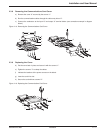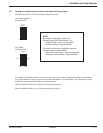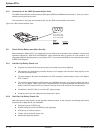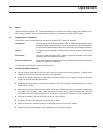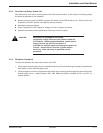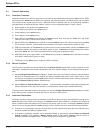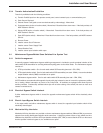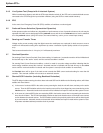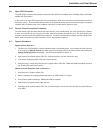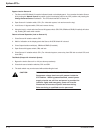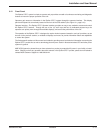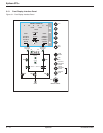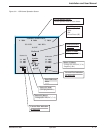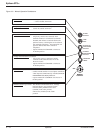
Installation and User Manual
3.3.4 Transfer Authorization/Prohibition
Transfer is prohibited under the following conditions:
a) Transfer Prohibit Input from the operator control panel, control contact input, or communications port.
b) Peak Current Overload.
c) External Power Fault (peak current overload caused by undervoltage) - Memorized.
d) Overtemperature (active or inactive switch) - Memorized. Reset fault from alarm menu. If the fault persists, call
MGE Customer Service.
e) Shorted SCR (active or inactive switch) – Memorized. Reset fault from alarm menu. If the fault persists, call
MGE Customer Service.
f) Open SCR (active switch) – Memorized. Reset fault from alarm menu. If the fault persists, call MGE Customer
Service.
g) Reverse Power.
h) Inactive source Out-of-Tolerance.
i) Inactive source Power Supply Fault.
j) Phase Rotation Fault.
k) Inactive source input isolation switch open.
3.4 Maintenance Bypass/Molded Case Switches/Live System Test
3.4.1 Switch Arrangement
A manually operated maintenance bypass switching arrangement is included to permit complete isolation of the
static switch SCR assemblies for servicing without disrupting power to the critical loads. The maintenance bypass
consists of :
a) STS input isolation switch. One for each static switch SCR assembly (two total - CB1, CB2).
b) STS output isolation switch. One for both static switch SCR assemblies (one total - CB3A). A second redundant
output isolation switch (CB3B) is available as an option.
c) Maintenance bypass switch. One for each static switch SCR assembly (two total – CB4, CB5).
All STS switches are automatic with magnetic trip only with
plug-in bases for ease of removal for replacement, calibra-
tion or testing, without
interruption of power to the critical load. All switches are equipped with shunt trips and
auxiliary contacts. Continuously activated shunt trips will not allow closing of the switch (not even as much as a
contact to contact touch).
3.4.2 Electrical Bypass Switch Interlock
If either maintenance bypass switch is closed, the opposite maintenance bypass switch will be electrically shunt
tripped.
3.4.3 Electric Input-Bypass Switch Interlock
If the output switch and either maintenance bypass switch is closed, the opposite input isolation switch will be
electrically shunt tripped.
3.4.4 Mechanical Key Interlocks
Mechanical Kirk key interlocks are provided on the two maintenance bypass switches (CB4 and CB5) to prevent an
operator from closing both bypass switches at the same time. A single key allows closure of one switch at a time.
Additional key interlocks on the two STS input isolation switches (CB1, CB2) to ensure that the STS is on the source
that the operator intends to bypass to, are available as an option.
Operation 3 —586-504004-00 B03



